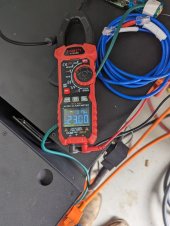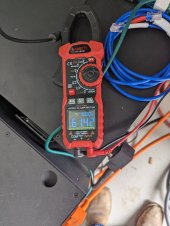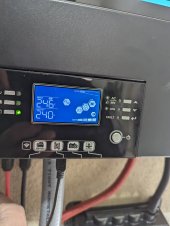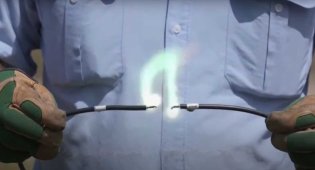I am helping my father install a 16 panel 6.4kW off grid ground mount system at his house in the Bahamas. These are setup as 4 individual strings (~190Voc, 10A), eventually feeding 2 LV6548 MPP Solar inverters in a split phase setup. At the moment, only one inverter has been installed and is operating, with 2 of the strings feeding each of its CCs. While doing work around the panels shortly after installing them and connecting them for the first time, my father noticed he was getting a light to moderate shock from the frames of the panels, and from what I understand the frame registered an AC voltage to ground on the multimeter (~50-60V from what I am told). He has since installed a ground rod at the array location and connected the frames to it, which has allowed that stray voltage on the frames to go away. However, the unused and unterminated wire runs (#10 THWN) that will in the future be connected to the other strings have also since delivered the same shock, and are also registering an AC voltage. These are in the same conduit as the active wire runs for ~80 feet. There is no grid power anywhere near the house or array or anything else in the conduit with the PV wires. So apparently they are picking up AC induction from the in-use PV wires - which still doesn't answer why the frames were somehow energized at one point or why AC is present in the first place.
On the AC side, the LV6548 is the location of our neutral-ground bond, with the bonding screw removed from the main power panel where the ground from a separate ground rod is referenced. There must be some sort of stray AC voltage getting onto the DC side of the inverter. I've seen a few references to people being shocked on the frames or perhaps AC induction from grid sources, but nothing that quite matches with this scenario. Does anybody have any idea of what could be going on?
Both my father and I are electrical engineers, btw. So we have some competence in this space, for better or worse.
On the AC side, the LV6548 is the location of our neutral-ground bond, with the bonding screw removed from the main power panel where the ground from a separate ground rod is referenced. There must be some sort of stray AC voltage getting onto the DC side of the inverter. I've seen a few references to people being shocked on the frames or perhaps AC induction from grid sources, but nothing that quite matches with this scenario. Does anybody have any idea of what could be going on?
Both my father and I are electrical engineers, btw. So we have some competence in this space, for better or worse.









